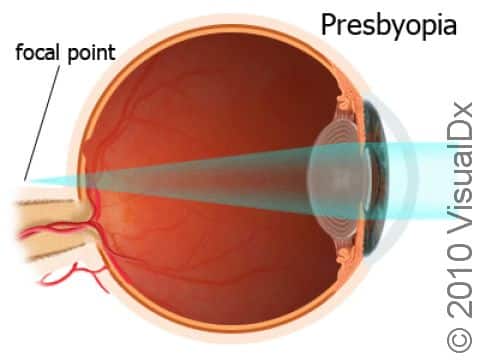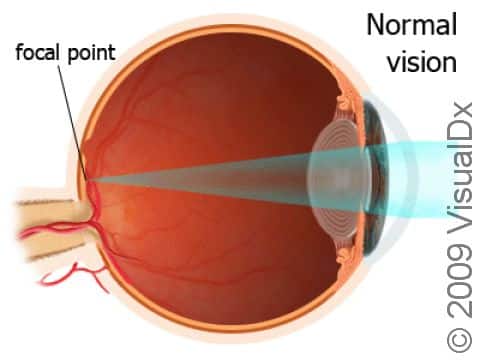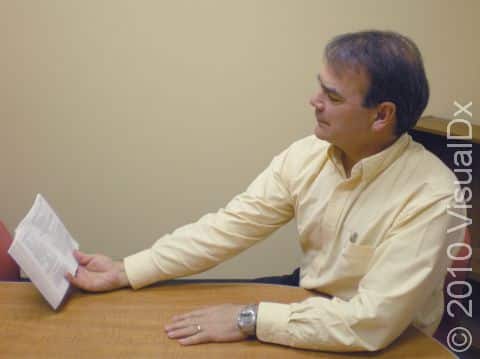Presbyopia
Presbyopia is an age-related change in vision in which a person loses the ability to see up close without corrective lenses or corrective surgery. The cause of presbyopia is a change in the ability of the human lens to adjust its shape (a process called accommodation) to allow a person to focus on objects that are at close range. The process of the lens losing its elasticity (accommodative ability) begins around age 10 years, but vision changes are not noticeable to a person until about age 40. Presbyopia usually continues to worsen until age 65.
Who's At Risk?
Anyone aged 40 years and older experiences presbyopia. The timing of it is dependent upon the underlying requirement for vision correction. In other words, if you have nearsightedness (ie, you have trouble seeing far away) and wear corrective lenses for this, you might not be aware of difficulty with presbyopia until later in life (eg, your late 40s or early 50s). However, if you have farsightedness (ie, you have trouble seeing up close that is not due to aging), you may experience presbyopia even before age 40. Certain general medical conditions, such as diabetes and high blood pressure, can cause presbyopia in people younger than 40.
Signs & Symptoms
Although you cannot see presbyopia just by looking at the eye, you will know it is happening when you notice:
- When reading, you need to hold the material farther from you.
- Difficulty with needlepoint, crochet, or near-vision-requiring hobbies.
- Difficulty seeing text on the computer screen.
- Reduced contrast and clarity of reading material.
- The need for brighter and more direct lighting for reading.
- Fatigue, headache, and/or eyestrain when reading or using the computer.
Self-Care Guidelines
There is nothing that can be done to prevent the natural process of presbyopia. However, ensuring you have good, bright, and well-focused light and holding reading material farther away when you read is often helpful. Good self-care also includes regular eye examinations, not only to preserve and protect your eyes but to detect whether you are getting presbyopia.
People with otherwise perfect eyesight who develop presbyopia can often use reading glasses found in drugstores and online. These are very simple magnification lenses, usually with powers from +1 to +4 diopters (a measure of lens power). Note that a different power is needed for use with the computer. Although reading glasses can be bought without a prescription, the specific power of reading glasses you need should be determined with an eye examination.
Treatments
Corrective glasses or contact lenses are most frequently used to treat presbyopia, but there are now many surgical procedures for vision correction. These surgical procedures (performed by ophthalmologists) are all considered refractive surgery, and they are used for the correction of myopia (nearsightedness), hyperopia (farsightedness), presbyopia (age-related loss of close vision), and astigmatism (irregular shaping of the cornea). There are also prescription eye drops that can be used to treat presbyopia.
Visit Urgency
See an eye-care professional for an eye examination, especially if:
- Difficulty with close vision prevents you from reading or doing close work comfortably.
- You find that working with the computer and/or reading has become difficult.
- You are having more headaches, eyestrain, fatigue, or frustration when trying to read and/or use the computer.
See a medical professional urgently if you have sudden vision changes, such as vision loss in one eye, blurry vision, double vision, or if you see large or ring-like floaters in your field of vision.
Trusted Links
References
Boyd K. What is presbyopia?. American Academy of Ophthalmology. https://www.aao.org/eye-health/diseases/what-is-presbyopia. 2022 Nov 22.
NIH. Presbyopia. National Eye institute. https://www.nei.nih.gov/learn-about-eye-health/eye-conditions-and-diseases/presbyopia. Updated 2023 Nov 15.
Riordan-Eva P. Optics & refraction. In: Riordan-Eva P, Augsburger JJ, eds. Vaughan & Asbury’s General Ophthalmology. 19th ed. New York, NY: McGraw-Hill; 2017.
Last modified on June 24th, 2024 at 11:17 am

Not sure what to look for?
Try our new Rash and Skin Condition Finder


